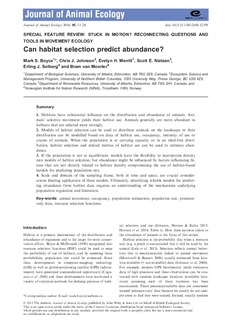Can habitat selection predict abundance?
Boyce, Mark S.; Johnson, Chris J.; Merrill, E.H.; Nielsen, Scott E.; Solberg, Erling Johan; Van Moorter, Bram
Journal article

Åpne
Permanent lenke
http://hdl.handle.net/11250/2480604Utgivelsesdato
2015Metadata
Vis full innførselSamlinger
- Publikasjoner fra CRIStin - NINA [2364]
- Scientific publications [1392]
Sammendrag
. Habitats have substantial influence on the distribut ion and abundance of animals. Ani-
mals’ selective mo vement yields their habitat use. Animals generally are more abundant in
habitats that are selected most strongly.
2. Models of habitat selection can be used to distribute animals on the landscape or their
distribution can be modelled based on data of habitat use, occupancy, intensity of use or
counts of animals. When the population is at carrying capacity or in an ideal-free distri-
bution, habitat selection and related metrics of habitat use can be used to estimate abun-
dance.
3. If the population is not at equilibrium, models have the flexibility to incorporate density
into models of habitat selection; but abundance might be influenced by factors influencing fit-
ness that are not directly related to habitat thereby compromising the use of habitat-based
models for predicting population size.
4. Scale and domain of the sampling fram e, both in time and space, are crucial consider-
ations limiting application of these models. Ultimately, identifying reliable models for predict-
ing abundance from habitat data requires an understanding of the mechanisms underlying
population regulation and limitation.
animal movement, occupancy, population estimation, population size, presence-
only data, resource selection functions